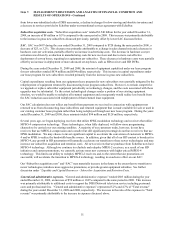Dish Network 2009 Annual Report Download - page 53
Download and view the complete annual report
Please find page 53 of the 2009 Dish Network annual report below. You can navigate through the pages in the report by either clicking on the pages listed below, or by using the keyword search tool below to find specific information within the annual report.Item 7. MANAGEMENT’S DISCUSSION AND ANALYSIS OF FINANCIAL CONDITION AND
RESULTS OF OPERATIONS - Continued
43
to target these subscribers for transition to another pay-TV service and we and AT&T are required to maintain
bundled billing and cooperative customer service for these subscribers, these subscribers may continue to churn at
higher than historical rates following termination of the AT&T distribution relationship.
We have been investing more in advanced technology equipment as part of our subscriber acquisition and retention
efforts. Recent initiatives to transmit certain programming only in MPEG-4 and to activate most new subscribers
only with MPEG-4 receivers have accelerated our deployment of MPEG-4 receivers. To meet current demand, we
have increased the rate at which we upgrade existing subscribers to HD and DVR receivers. While these efforts
may increase our subscriber acquisition and retention costs, we believe that they will help reduce subscriber churn
and costs over the long run.
We have also been changing equipment to migrate certain subscribers to make more efficient use of transponder
capacity in support of HD and other initiatives. We expect to continue these initiatives through 2010. We believe
that the benefit from the increase in available transponder capacity outweighs the short-term cost of these equipment
changes.
To combat signal theft and improve the security of our broadcast system, we recently completed the replacement of
our security access devices to re-secure our system. We expect additional future replacements of these devices to be
necessary to keep our system secure. To combat other forms of fraud, we have taken a wide range of actions
including terminating retailers that we believe were in violation of DISH Network’s business rules. While these
initiatives may inconvenience our subscribers and disrupt our distribution channels in the short-term, we believe that
the long-term benefits will outweigh the costs.
To address our operational inefficiencies, we have streamlined our hardware offerings and continue to make
significant investments in staffing, training, information systems, and other initiatives, primarily in our call center
and in-home service operations. These investments are intended to help combat inefficiencies introduced by the
increasing complexity of our business, improve customer satisfaction, reduce churn, increase productivity, and allow
us to scale better over the long run. We cannot, however, be certain that our increased spending will ultimately be
successful in yielding such returns. In the meantime, we may continue to incur higher costs as a result of both our
operational inefficiencies and increased spending. The adoption of these measures has contributed to higher
expenses and lower margins. While we believe that the increased costs will be outweighed by longer-term benefits,
there can be no assurance when or if we will realize these benefits at all.
Programming costs represent a large percentage of our “Subscriber-related expenses.” As a result, our margins may
face further downward pressure from price increases and the renewal of long-term programming contracts on less
favorable pricing terms.
To maintain and enhance our competitiveness over the long term, we plan to promote a suite of integrated products
designed to maximize the convenience and ease of watching TV anytime and anywhere, which we refer to as, “TV
Everywhere.” TV Everywhere utilizes, among other things, Slingbox “placeshifting” technology.
Liquidity Drivers
Like many companies, we make general investments in property such as satellites, information technology and
facilities that support our overall business. As a subscriber-based company, however, we also make subscriber-
specific investments to acquire new subscribers and retain existing subscribers. While the general investments may
be deferred without impacting the business in the short-term, the subscriber-specific investments are less
discretionary. Our overall objective is to generate sufficient cash flow over the life of each subscriber to provide an
adequate return against the upfront investment. Once the upfront investment has been made for each subscriber, the
subsequent cash flow is generally positive.
There are a number of factors that impact our future cash flow compared to the cash flow we generate at a given
point in time. The first factor is how successful we are at retaining our current subscribers. As we lose subscribers
from our existing base, the positive cash flow from that base is correspondingly reduced. The second factor is how
successful we are at maintaining our subscriber-related margins. To the extent our “Subscriber-related expenses”
grow faster than our “Subscriber-related revenue,” the amount of cash flow that is generated per existing subscriber
























